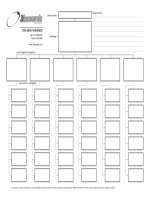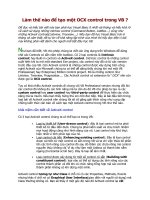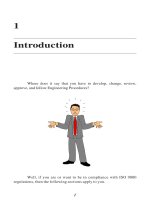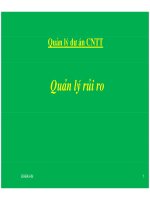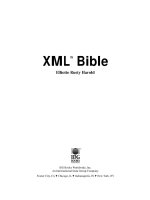Tài liệu XML™ Bible - Elliotte Rusty Harold docx
Bạn đang xem bản rút gọn của tài liệu. Xem và tải ngay bản đầy đủ của tài liệu tại đây (6.14 MB, 996 trang )
XML
™
Bible
Elliotte Rusty Harold
IDG Books Worldwide, Inc.
An International Data Group Company
Foster City, CA ✦ Chicago, IL ✦ Indianapolis, IN ✦ New York, NY
3236-7 FM.F.qc 6/30/99 2:59 PM Page iii
XML™ Bible
Published by
IDG Books Worldwide, Inc.
An International Data Group Company
919 E. Hillsdale Blvd., Suite 400
Foster City, CA 94404
www.idgbooks.com
(IDG Books Worldwide Web site)
Copyright © 1999 IDG Books Worldwide, Inc. All rights
reserved. No part of this book, including interior
design, cover design, and icons, may be reproduced or
transmitted in any form, by any means (electronic,
photocopying, recording, or otherwise) without the
prior written permission of the publisher.
ISBN: 0-7645-3236-7
Printed in the United States of America
10 9 8 7 6 5 4 3 2 1
1O/QV/QY/ZZ/FC
Distributed in the United States by IDG Books
Worldwide, Inc.
Distributed by CDG Books Canada Inc. for Canada; by
Transworld Publishers Limited in the United Kingdom;
by IDG Norge Books for Norway; by IDG Sweden Books
for Sweden; by IDG Books Australia Publishing
Corporation Pty. Ltd. for Australia and New Zealand; by
TransQuest Publishers Pte Ltd. for Singapore,
Malaysia, Thailand, Indonesia, and Hong Kong; by
Gotop Information Inc. for Taiwan; by ICG Muse, Inc.
for Japan; by Norma Comunicaciones S.A. for
Colombia; by Intersoft for South Africa; by Eyrolles for
France; by International Thomson Publishing for
Germany, Austria and Switzerland; by Distribuidora
Cuspide for Argentina; by Livraria Cultura for Brazil; by
Ediciones ZETA S.C.R. Ltda. for Peru; by WS Computer
Publishing Corporation, Inc., for the Philippines; by
Contemporanea de Ediciones for Venezuela; by
Express Computer Distributors for the Caribbean and
West Indies; by Micronesia Media Distributor, Inc. for
Micronesia; by Grupo Editorial Norma S.A. for
Guatemala; by Chips Computadoras S.A. de C.V. for
Mexico; by Editorial Norma de Panama S.A. for
Panama; by American Bookshops for Finland.
Authorized Sales Agent: Anthony Rudkin Associates for
the Middle East and North Africa.
For general information on IDG Books Worldwide’s
books in the U.S., please call our Consumer Customer
Service department at 800-762-2974. For reseller
information, including discounts and premium sales,
please call our Reseller Customer Service department
at 800-434-3422.
For information on where to purchase IDG Books
Worldwide’s books outside the U.S., please contact our
International Sales department at 317-596-5530 or fax
317-596-5692.
For consumer information on foreign language
translations, please contact our Customer Service
department at 800-434-3422, fax 317-596-5692, or e-mail
.
For information on licensing foreign or domestic rights,
please phone +1-650-655-3109.
For sales inquiries and special prices for bulk
quantities, please contact our Sales department at
650-655-3200 or write to the address above.
For information on using IDG Books Worldwide’s books
in the classroom or for ordering examination copies,
please contact our Educational Sales department at
800-434-2086 or fax 317-596-5499.
For press review copies, author interviews, or other
publicity information, please contact our Public
Relations department at 650-655-3000 or fax
650-655-3299.
For authorization to photocopy items for corporate,
personal, or educational use, please contact Copyright
Clearance Center, 222 Rosewood Drive, Danvers, MA
01923, or fax 978-750-4470.
Library of Congress Cataloging-in-Publication Data
Harold, Elliote Rusty.
XML bible / Elliote Rusty Harold.
p. cm.
ISBN 0-7645-3236-7 (alk. paper)
1. XML (Document markup language) I. Title.
QA76.76.H94H34 1999 99-31021
005.7’2--dc21 CIP
LIMIT OF LIABILITY/DISCLAIMER OF WARRANTY: THE PUBLISHER AND AUTHOR HAVE USED THEIR BEST
EFFORTS IN PREPARING THIS BOOK. THE PUBLISHER AND AUTHOR MAKE NO REPRESENTATIONS OR
WARRANTIES WITH RESPECT TO THE ACCURACY OR COMPLETENESS OF THE CONTENTS OF THIS BOOK
AND SPECIFICALLY DISCLAIM ANY IMPLIED WARRANTIES OF MERCHANTABILITY OR FITNESS FOR A
PARTICULAR PURPOSE. THERE ARE NO WARRANTIES WHICH EXTEND BEYOND THE DESCRIPTIONS
CONTAINED IN THIS PARAGRAPH. NO WARRANTY MAY BE CREATED OR EXTENDED BY SALES
REPRESENTATIVES OR WRITTEN SALES MATERIALS. THE ACCURACY AND COMPLETENESS OF THE
INFORMATION PROVIDED HEREIN AND THE OPINIONS STATED HEREIN ARE NOT GUARANTEED OR
WARRANTED TO PRODUCE ANY PARTICULAR RESULTS, AND THE ADVICE AND STRATEGIES CONTAINED
HEREIN MAY NOT BE SUITABLE FOR EVERY INDIVIDUAL. NEITHER THE PUBLISHER NOR AUTHOR SHALL
BE LIABLE FOR ANY LOSS OF PROFIT OR ANY OTHER COMMERCIAL DAMAGES, INCLUDING BUT NOT
LIMITED TO SPECIAL, INCIDENTAL, CONSEQUENTIAL, OR OTHER DAMAGES.
Trademarks: All brand names and product names used in this book are trade names, service marks, trademarks,
or registered trademarks of their respective owners. IDG Books Worldwide is not associated with any product or
vendor mentioned in this book.
is a registered trademark or trademark under exclusive license
to IDG Books Worldwide, Inc. from International Data Group, Inc.
in the United States and/or other countries.
3236-7 FM.F.qc 6/30/99 2:59 PM Page iv
Eleventh Annual
Computer Press
Awards 1995
Tenth Annual
Computer Press
Awards 1994
Eighth Annual
Computer Press
Awards 1992
Ninth Annual
Computer Press
Awards 1993
IDG is the world’s leading IT media, research and exposition company. Founded in 1964, IDG had 1997 revenues of $2.05
billion and has more than 9,000 employees worldwide. IDG offers the widest range of media options that reach IT buyers
in 75 countries representing 95% of worldwide IT spending. IDG’s diverse product and services portfolio spans six key areas
including print publishing, online publishing, expositions and conferences, market research, education and training, and
global marketing services. More than 90 million people read one or more of IDG’s 290 magazines and newspapers, including
IDG’s leading global brands — Computerworld, PC World, Network World, Macworld and the Channel World family of
publications. IDG Books Worldwide is one of the fastest-growing computer book publishers in the world, with more than
700 titles in 36 languages. The “...For Dummies
®
” series alone has more than 50 million copies in print. IDG offers online
users the largest network of technology-specific Web sites around the world through IDG.net (), which
comprises more than 225 targeted Web sites in 55 countries worldwide. International Data Corporation (IDC) is the world’s
largest provider of information technology data, analysis and consulting, with research centers in over 41 countries and more
than 400 research analysts worldwide. IDG World Expo is a leading producer of more than 168 globally branded conferences
and expositions in 35 countries including E3 (Electronic Entertainment Expo), Macworld Expo, ComNet, Windows World
Expo, ICE (Internet Commerce Expo), Agenda, DEMO, and Spotlight. IDG’s training subsidiary, ExecuTrain, is the world’s
largest computer training company, with more than 230 locations worldwide and 785 training courses. IDG Marketing
Services helps industry-leading IT companies build international brand recognition by developing global integrated marketing
programs via IDG’s print, online and exposition products worldwide. Further information about the company can be found
at www.idg.com. 1/24/99
Welcome to the world of IDG Books Worldwide.
IDG Books Worldwide, Inc., is a subsidiary of International Data Group, the world’s largest publisher of
computer-related information and the leading global provider of information services on information technology.
IDG was founded more than 30 years ago by Patrick J. McGovern and now employs more than 9,000 people
worldwide. IDG publishes more than 290 computer publications in over 75 countries. More than 90 million
people read one or more IDG publications each month.
Launched in 1990, IDG Books Worldwide is today the #1 publisher of best-selling computer books in the
United States. We are proud to have received eight awards from the Computer Press Association in recognition
of editorial excellence and three from Computer Currents’ First Annual Readers’ Choice Awards. Our best-
selling ...For Dummies
®
series has more than 50 million copies in print with translations in 31 languages. IDG
Books Worldwide, through a joint venture with IDG’s Hi-Tech Beijing, became the first U.S. publisher to
publish a computer book in the People’s Republic of China. In record time, IDG Books Worldwide has become
the first choice for millions of readers around the world who want to learn how to better manage their
businesses.
Our mission is simple: Every one of our books is designed to bring extra value and skill-building instructions
to the reader. Our books are written by experts who understand and care about our readers. The knowledge
base of our editorial staff comes from years of experience in publishing, education, and journalism —
experience we use to produce books to carry us into the new millennium. In short, we care about books, so
we attract the best people. We devote special attention to details such as audience, interior design, use of
icons, and illustrations. And because we use an efficient process of authoring, editing, and desktop publishing
our books electronically, we can spend more time ensuring superior content and less time on the technicalities
of making books.
You can count on our commitment to deliver high-quality books at competitive prices on topics you want
to read about. At IDG Books Worldwide, we continue in the IDG tradition of delivering quality for more than
30 years. You’ll find no better book on a subject than one from IDG Books Worldwide.
John Kilcullen Steven Berkowitz
Chairman and CEO President and Publisher
IDG Books Worldwide, Inc. IDG Books Worldwide, Inc.
3236-7 FM.F.qc 6/30/99 2:59 PM Page v
Credits
Acquisitions Editor
John Osborn
Development Editor
Terri Varveris
Contributing Writer
Heather Williamson
Technical Editor
Greg Guntle
Copy Editors
Amy Eoff
Amanda Kaufman
Nicole LeClerc
Victoria Lee
Production
IDG Books Worldwide Production
Proofreading and Indexing
York Production Services
About the Author
Elliotte Rusty Harold is an internationally respected writer, programmer, and
educator both on the Internet and off. He got his start by writing FAQ lists for the
Macintosh newsgroups on Usenet, and has since branched out into books, Web
sites, and newsletters. He lectures about Java and object-oriented programming
at Polytechnic University in Brooklyn. His Cafe con Leche Web site at
http://
metalab.unc.edu/xml/
has become one of the most popular independent XML
sites on the Internet.
Elliotte is originally from New Orleans where he returns periodically in search of
a decent bowl of gumbo. However, he currently resides in the Prospect Heights
neighborhood of Brooklyn with his wife Beth and cats Charm (named after the
quark) and Marjorie (named after his mother-in-law). When not writing books, he
enjoys working on genealogy, mathematics, and quantum mechanics. His previous
books include The Java Developer’s Resource, Java Network Programming, Java
Secrets, JavaBeans, XML: Extensible Markup Language, and Java I/O.
3236-7 FM.F.qc 6/30/99 2:59 PM Page vi
For Ma, a great grandmother
3236-7 FM.F.qc 6/30/99 2:59 PM Page vii
3236-7 FM.F.qc 6/30/99 2:59 PM Page viii
Preface
Welcome to the XML Bible. After reading this book I hope you’ll agree with me that
XML is the most exciting development on the Internet since Java, and that it makes
Web site development easier, more productive, and more fun.
This book is your introduction to the exciting and fast growing world of XML. In this
book, you’ll learn how to write documents in XML and how to use style sheets to
convert those documents into HTML so legacy browsers can read them. You’ll
also learn how to use document type definitions (DTDs) to describe and validate
documents. This will become increasingly important as more and more browsers like
Mozilla and Internet Explorer 5.0 provide native support for XML.
About You the Reader
Unlike most other XML books on the market, the XML Bible covers XML not from
the perspective of a software developer, but rather that of a Web-page author. I
don’t spend a lot of time discussing BNF grammars or parsing element trees.
Instead, I show you how you can use XML and existing tools today to more
efficiently produce attractive, exciting, easy-to-use, easy-to-maintain Web sites
that keep your readers coming back for more.
This book is aimed directly at Web-site developers. I assume you want to use XML
to produce Web sites that are difficult to impossible to create with raw HTML. You’ll
be amazed to discover that in conjunction with style sheets and a few free tools,
XML enables you to do things that previously required either custom software
costing hundreds to thousands of dollars per developer, or extensive knowledge
of programming languages like Perl. None of the software in this book will cost
you more than a few minutes of download time. None of the tricks require any
programming.
What You Need to Know
XML does build on HTML and the underlying infrastructure of the Internet. To that
end, I will assume you know how to use ftp files, send email, and load URLs in your
Web browser of choice. I will also assume you have a reasonable knowledge of
HTML at about the level supported by Netscape 1.1. On the other hand, when I
discuss newer aspects of HTML that are not yet in widespread use like cascading
style sheets, I will cover them in depth.
3236-7 FM.F.qc 6/30/99 2:59 PM Page ix
x
Preface
To be more specific, in this book I assume that you can:
✦ Write a basic HTML page including links, images, and text using a text editor.
✦ Place that page on a Web server.
On the other hand, I do not assume that you:
✦ Know SGML. In fact, this preface is almost the only place in the entire book
you’ll see the word SGML used. XML is supposed to be simpler and more
widespread than SGML. It can’t be that if you have to learn SGML first.
✦ Are a programmer, whether of Java, Perl, C, or some other language, XML is
a markup language, not a programming language. You don’t need to be a
programmer to write XML documents.
What You’ll Learn
This book has one primary goal; to teach you to write XML documents for the Web.
Fortunately, XML has a decidedly flat learning curve, much like HTML (and unlike
SGML). As you learn a little you can do a little. As you learn a little more, you can do
a little more. Thus the chapters in this book build steadily on each other. They are
meant to be read in sequence. Along the way you’ll learn:
✦ How an XML document is created and delivered to readers.
✦ How semantic tagging makes XML documents easier to maintain and develop
than their HTML equivalents.
✦ How to post XML documents on Web servers in a form everyone can read.
✦ How to make sure your XML is well-formed.
✦ How to use international characters like _ and _ in your documents.
✦ How to validate documents with DTDs.
✦ How to use entities to build large documents from smaller parts.
✦ How attributes describe data.
✦ How to work with non-XML data.
✦ How to format your documents with CSS and XSL style sheets.
✦ How to connect documents with XLinks and Xpointers.
✦ How to merge different XML vocabularies with namespaces.
✦ How to write metadata for Web pages using RDF.
3236-7 FM.F.qc 6/30/99 2:59 PM Page x
xi
Preface
In the final section of this book, you’ll see several practical examples of XML being
used for real-world applications including:
✦ Web Site Design
✦ Push
✦ Vector Graphics
✦ Genealogy
How the Book Is Organized
This book is divided into five parts and includes three appendixes:
I. Introducing XML
II. Document Type Definitions
III. Style Languages
IV. Supplemental Technologies
V. XML Applications
By the time you’re finished reading this book, you’ll be ready to use XML to create
compelling Web pages. The five parts and the appendixes are described below.
Part I: Introducing XML
Part I consists of Chapters 1 through 7. It begins with the history and theory behind
XML, the goals XML is trying to achieve, and shows you how the different pieces of
the XML equation fit together to create and deliver documents to readers. You’ll see
several compelling examples of XML applications to give you some idea of the wide
applicability of XML, including the Vector Markup Language (VML), the Resource
Description Framework (RDF), the Mathematical Markup Language (MathML), the
Extensible Forms Description Language (XFDL), and many others. Then you’ll learn
by example how to write XML documents with tags you define that make sense for
your document. You’ll see how to edit them in a text editor, attach style sheets to
them, and load them into a Web browser like Internet Explorer 5.0 or Mozilla. You’ll
even learn how you can write XML documents in languages other than English,
even languages that aren’t written remotely like English, such as Chinese, Hebrew,
and Russian.
3236-7 FM.F.qc 6/30/99 2:59 PM Page xi
xii
Preface
Part II: Document Type Definitions
Part II consists of Chapters 8 through 11, all of which focus on document type
definitions (DTDs). An XML document may optionally contain a DTD that specifies
which elements are and are not allowed in an XML document. The DTD specifies
the exact context and structure of those elements. A validating parser can read a
document and compare it to its DTD, and report any mistakes it finds. This enables
document authors to make sure that their work meets any necessary criteria.
In Part II, you’ll learn how to attach a DTD to a document, how to validate your
documents against their DTDs, and how to write your own DTDs that solve your
own problems. You’l learn the syntax for declaring elements, attributes, entities,
and notations. You’ll see how you can use entity declarations and entity references
to build both a document and its DTD from multiple, independent pieces. This
allows you to make long, hard-to-follow documents much simpler by separating
them into related modules and components. And you’ll learn how to integrate other
forms of data like raw text and GIF image files in your XML document.
Part III: Style Languages
Part III consists of Chapters 12 through 15. XML markup only specifies what’s in a
document. Unlike HTML, it does not say anything about what that content should
look like. Information about an XML document’s appearance when printed, viewed
in a Web browser, or otherwise displayed is stored in a style sheet. Different style
sheets can be used for the same document. You might, for instance, want to use a
style sheet that specifies small fonts for printing, another one that uses larger fonts
for on-screen use, and a third with absolutely humongous fonts to project the
document on a wall at a seminar. You can change the appearance of an XML docu-
ment by choosing a different style sheet without touching the document itself.
Part III describes in detail the two style sheet languanges in broadest use on the
Web, Cascading Style Sheets (CSS) and the Extensible Style Language (XSL).
CSS is a simple style-sheet language originally designed for use with HTML. CSS
exists in two versions: CSS Level 1 and CSS Level 2. CSS Level 1 provides basic
information about fonts, color, positioning, and text properties, and is reasonably
well supported by current Web browsers for HTML and XML. CSS Level 2 is a more
recent standard that adds support for aural style sheets, user interface styles,
international and bi-directional text, and more. CSS is a relatively simple standard
that spplies fixed style rules to the contents of particular elements.
XSL, by contrast, is a more complicated and more powerful style language that cannot
only apply styles to the contents of elements but can also rearrange elements, add
boilerplate text, and transform documents in almost arbitrary ways. XSL is divided
into two parts: a transformation language for converting XML trees to alternative
trees, and a formatting language for specifying the appearance of the elements of an
XML tree. Currently, the transformation language is better supported by most tools
3236-7 FM.F.qc 6/30/99 2:59 PM Page xii
xiii
Preface
than the formatting language. Nonetheless, it is beginning to firm up, and is supported
by Microsoft Internet Explorer 5.0 and some third-party formatting engines.
Part IV: Supplemental Technologies
Part IV consists of Chapters 16 through 19. It introduces some XML-based languages
and syntaxes that layer on top of basic XML. XLinks provides multi-directional
hypertext links that are far more powerful than the simple HTML
<A>
tag. XPointers
introduce a new syntax you can attach to the end of URLs to link not only to parti-
cular documents, but to particular parts of particular documents. Namespaces use
prefixes and URLs to disambiguate conflicting XML markup languages. The Resource
Description Framework (RDF) is an XML application used to embed meta-data in
XML and HTML documents. Meta-data is information about a document, such as the
author, date, and title of a work, rather than the work itself. All of these can be added
to your own XML-based markup languages to extend their power and utility.
Part V: XML Applications
Part V, which consists of Chapters 20–23, shows you four practical uses of XML in
different domains. XHTML is a reformulation of HTML 4.0 as valid XML. Microsoft’s
Channel Definition Format (CDF), is an XML-based markup language for defining
channels that can push updated Web site content to subscribers. The Vector
Markup Language (VML) is an XML application for scalable graphics used by Micro-
soft Office 2000 and Internet Explorer 5.0. Finally, a completely new application is
developed for genealogical data to show you not just how to use XML tags, but why
and when to choose them.
Appendixes
This book has two appendixes, which focus on the formal specifications for XML, as
opposed to the more informal description of it used throughout the rest of the
book. Appendix A provides detailed explanations of three individual parts of the
XML 1.0 specification: XML BNF grammar, well-formedness constraints, and the
validity constraints. Appendix B contains the official W3C XML 1.0 specification
published by the W3C. The book also has a third appendix, Appendix C, which
describes the contents of the CD-ROM that accompanies this book.
What You Need
To make the best use of this book and XML, you need:
✦ A PC running Windows 95, Windows 98, or Windows NT
✦ Internet Explorer 5.0
✦ A Java 1.1 or later virtual machine
3236-7 FM.F.qc 6/30/99 2:59 PM Page xiii
xiv
Preface
Any system that can run Windows will suffice. In this book, I mostly assume you’re
using Windows 95 or NT 4.0 or later. As a longtime Mac and Unix user, I somewhat
regret this. Like Java, XML is supposed to be platform independent. Also like Java,
the reality is somewhat short of the hype. Although XML code is pure text that can
be written with any editor, many of the tools are currently only available on
Windows.
However, although there aren’t many Unix or Macintosh native XML programs,
there are an increasing number of XML programs written in Java. If you have a Java
1.1 or later virtual machine on your platform of choice, you should be able to make
do. Even if you can’t load your XML documents directly into a Web browser, you
can still convert them to XML documents and view those. When Mozilla is released,
it should provide the best XML browser yet across multiple platforms.
How to Use This Book
This book is designed to be read more or less cover to cover. Each chapter builds
on the material in the previous chapters in a fairly predictable fashion. Of course,
you’re always welcome to skim over material that’s already familiar to you. I also
hope you’ll stop along the way to try out some of the examples and to write some
XML documents of your own. It’s important to learn not just by reading, but also by
doing. Before you get started, I’d like to make a couple of notes about grammatical
conventions used in this book.
Unlike HTML, XML is case sensitive.
<FATHER>
is not the same as
<Father>
or
<father>
. The
father
element is not the same as the
Father
element or the
FATHER
element. Unfortunately, case-sensitive markup languages have an annoying
habit of conflicting with standard English usage. On rare occasion this means
that you may encounter sentences that don’t begin with a capital letter. More
commonly, you’ll see capitalization used in the middle of a sentence where you
wouldn’t normally expect it. Please don’t get too bothered by this. All XML and
HTML code used in this book is placed in a monospaced font, so most of the time
it will be obvious from the context what is meant.
I have also adopted the British convention of only placing punctuation inside quote
marks when it belongs with the material quoted. Frankly, although I learned to write
in the American educational system, I find the British system is far more logical,
especially when dealing with source code where the difference between a comma
or a period and no punctuation at all can make the difference between perfectly
correct and perfectly incorrect code.
3236-7 FM.F.qc 6/30/99 2:59 PM Page xiv
xv
Preface
What the Icons Mean
Throughout the book, I’ve used icons in the left margin to call your attention to
points that are particularly important.
Note icons provide supplemental information about the subject at hand, but gen-
erally something that isn’t quite the main idea. Notes are often used to elaborate
on a detailed technical point.
Tip icons indicate a more efficient way of doing something, or a technique that
may not be obvious.
CD-ROM icons tell you that software discussed in the book is available on the
companion CD-ROM. This icon also tells you if a longer example, discussed but
not included in its entirety in the book, is on the CD-ROM.
Caution icons warn you of a common misconception or that a procedure doesn’t
always work quite like it’s supposed to. The most common purpose of a Caution
icon in this book is to point out the difference between what a specification says
should happen, and what actually does.
The Cross Reference icon refers you to other chapters that have more to say about
a particular subject.
About the Companion CD-ROM
The inside back cover of this book contains a CD-ROM that holds all numbered
code listings that you’ll find in the text. It also includes many longer examples that
couldn’t fit into this book. The CD-ROM also contains the complete text of various
XML specifications in HTML. (Some of the specifications will be in other formats as
well.) Finally, you will find an assortment of useful software for working with XML
documents. Many (though not all) of these programs are written in Java, so they’ll
run on any system with a reasonably compatible Java 1.1 or later virtual machine.
Most of the programs that aren’t written in Java are designed for Windows 95, 98,
and NT.
For a complete description of the CD-ROM contents, you can read Appendix C. In
addition, to get a complete description of what is on the CD-ROM, you can load the
file index.html onto your Web browser. The files on the companion CD-ROM are not
compressed, so you can access them directly from the CD.
Cross-
Reference
Caution
On the
CD-ROM
Tip
Note
3236-7 FM.F.qc 6/30/99 2:59 PM Page xv
xvi
Preface
Reach Out
The publisher and I want your feedback. After you have had a chance to use this
book, please take a moment to complete the IDG Books Worldwide Registration
Card (in the back of the book). Please be honest in your evaluation. If you thought a
particular chapter didn’t tell you enough, let me know. Of course, I would prefer to
receive comments like: “This is the best book I’ve ever read”, “Thanks to this book,
my Web site won Cool Site of the Year”, or “When I was reading this book on the
beach, I was besieged by models who thought I was super cool”, but I’ll take any
comments I can get :-).
Feel free to send me specific questions regarding the material in this book. I’ll do
my best to help you out and answer your questions, but I can’t guarantee a reply.
The best way to reach me is by email:
Also, I invite you to visit my Cafe con Leche Web site at
.
edu/xml/
, which contains a lot of XML-related material and is updated almost
daily. Despite my persistent efforts to make this book perfect, some errors have
doubtless slipped by. Even more certainly, some of the material discussed here
will change over time. I’ll post any necessary updates and errata on my Web site at
/>. Please let me know via email of
any errors that you find that aren’t already listed.
Elliotte Rusty Harold
/>New York City, June 1999
3236-7 FM.F.qc 6/30/99 2:59 PM Page xvi
Acknowledgments
The folks at IDG have all been great. The acquisitions editor, John Osborn, deserves
special thanks for arranging the unusual scheduling this book required to hit the
moving target XML presents. Terri Varveris shepherded this book through the
development process. With poise and grace, she managed the constantly shifting
outline and schedule that a book based on unstable specifications and software
requires. Amy Eoff corrected many of my grammatical shortcomings. Susan Parini
and Ritchie Durdin, the production coordinators, also deserve special thanks for
managing the production of this book and for dealing with last-minute figure
changes.
Steven Champeon brought his SGML experience to the book, and provided many
insightful comments on the text. My brother Thomas Harold put his command
of chemistry at my disposal when I was trying to grasp the Chemical Markup
Language. Carroll Bellau provided me with parts of my family tree, which you’ll
find in Chapter 17.
I also greatly appreciate all the comments, questions, and corrections sent in by
readers of my previous book, XML: Extensible Markup Language. I hope that I’ve
managed to address most of those comments in this book. They’ve definitely
helped make XML Bible a better book. Particular thanks are due to Alan Esenther
and Donald Lancon Jr. for their especially detailed comments.
WandaJane Phillips wrote the original version of Chapter 21 on CDF that is adapted
here. Heather Williamson, in addition to performing yeoman-like service as technical
editor, wrote Chapter 13, CSS Level 2, and parts of Chapters 18, 19, and 22. Her help
was instrumental in helping me almost meet my deadline. (Blame for this almost
rests on my shoulders, not theirs.) Also, I would like to thank Piroz Mohseni, who
also served as a technical editor for this book.
The agenting talents of David and Sherry Rogelberg of the Studio B Literary Agency
(
/>) have made it possible for me to write more or less
full-time. I recommend them highly to anyone thinking about writing computer
books. And as always, thanks go to my wife Beth for her endless love and
understanding.
3236-7 FM.F.qc 6/30/99 2:59 PM Page xvii
3236-7 FM.F.qc 6/30/99 2:59 PM Page xviii
Contents at a Glance
Preface ................................................................................................................................ix
Acknowledgments ..........................................................................................................xvii
Part I: Introducing XML ......................................................................................1
Chapter 1: An Eagle’s Eye View of XML ..........................................................................3
Chapter 2: An Introduction to XML Applications ........................................................17
Chapter 3: Your First XML Document ..........................................................................49
Chapter 4: Structuring Data ............................................................................................59
Chapter 5: Attributes, Empty Tags, and XSL ................................................................95
Chapter 6: Well-Formed XML Documents
Chapter 7: Foreign Languages and Non-Roman Text ................................................161
Part II: Document Type Definitions ............................................................189
Chapter 8: Document Type Definitions and Validity ................................................191
Chapter 9: Entities and External DTD Subsets ..........................................................247
Chapter 10: Attribute Declarations in DTDs ..............................................................283
Chapter 11: Embedding Non-XML Data ......................................................................307
Part III: Style Languages................................................................................321
Chapter 12: Cascading Style Sheets Level 1 ..............................................................323
Chapter 13: Cascading Style Sheets Level 2 ..............................................................389
Chapter 14: XSL Transformations ................................................................................433
Chapter 15: XSL Formatting Objects ..........................................................................513
Part IV: Supplemental Technologies ..........................................................569
Chapter 16: XLinks ........................................................................................................571
Chapter 17: XPointers ..................................................................................................591
Chapter 18: Namespaces ..............................................................................................617
Chapter 19: The Resource Description Framework ..................................................631
PartV: XML Applications ................................................................................655
Chapter 20: Reading Document Type Definitions ......................................................657
Chapter 21: Pushing Web Sites with CDF ....................................................................775
Chapter 22: The Vector Markup Language ................................................................805
Chapter 23: Designing a New XML Application ..........................................................833
3236-7 FM.F.qc 6/30/99 2:59 PM Page xix
xx
Contents at a Glance
Appendix A: XML Reference Material ........................................................................863
Appendix B: The XML 1.0 Specification ......................................................................921
Appendix C: What’s on the CD-ROM ............................................................................971
Index ................................................................................................................................975
End-User License Agreement ......................................................................................1018
CD-ROM Installation Instructions ..............................................................................1022
3236-7 FM.F.qc 6/30/99 2:59 PM Page xx
Contents
Preface ................................................................................................................................ix
Acknowledgments ..........................................................................................................xvii
Part I: Introducing XML 1
Chapter 1: An Eagle’s Eye View of XML ........................................................3
What Is XML? ............................................................................................................3
XML Is a Meta-Markup Language .................................................................3
XML Describes Structure and Semantics, Not Formatting ........................4
Why Are Developers Excited about XML? ............................................................6
Design of Domain-Specific Markup Languages ...........................................6
Self-Describing Data .......................................................................................6
Interchange of Data Among Applications ....................................................7
Structured and Integrated Data ....................................................................8
The Life of an XML Document ................................................................................8
Editors .............................................................................................................9
Parsers and Processors .................................................................................9
Browsers and Other Tools ............................................................................9
The Process Summarized ............................................................................10
Related Technologies ............................................................................................10
Hypertext Markup Language ......................................................................10
Cascading Style Sheets ................................................................................11
Extensible Style Language ...........................................................................12
URLs and URIs ..............................................................................................12
XLinks and XPointers ...................................................................................13
The Unicode Character Set .........................................................................14
How the Technologies Fit Together ...........................................................14
Chapter 2: An Introduction to XML Applications ......................................17
What Is an XML Application? ................................................................................17
Chemical Markup Language ........................................................................18
Mathematical Markup Language ................................................................19
Channel Definition Format ..........................................................................22
Classic Literature .........................................................................................22
Synchronized Multimedia Integration Language ......................................24
HTML+TIME ..................................................................................................25
Open Software Description .........................................................................26
Scalable Vector Graphics ............................................................................27
Vector Markup Language .............................................................................29
MusicML ........................................................................................................30
VoxML ............................................................................................................32
3236-7 FM.F.qc 6/30/99 2:59 PM Page xxi
xxii
Contents
Open Financial Exchange ............................................................................34
Extensible Forms Description Language ...................................................36
Human Resources Markup Language ........................................................38
Resource Description Framework ..............................................................40
XML for XML ...........................................................................................................42
XSL .................................................................................................................42
XLL .................................................................................................................43
DCD ................................................................................................................43
Behind-the-Scene Uses of XML .............................................................................44
Chapter 3: Your First XML Document ..........................................................49
Hello XML ................................................................................................................49
Creating a Simple XML Document ..............................................................50
Saving the XML File ......................................................................................50
Loading the XML File into a Web Browser ................................................51
Exploring the Simple XML Document ..................................................................52
Assigning Meaning to XML Tags ...........................................................................54
Writing a Style Sheet for an XML Document .......................................................55
Attaching a Style Sheet to an XML Document ....................................................56
Chapter 4: Structuring Data ..........................................................................59
Examining the Data ................................................................................................59
Batters ...........................................................................................................60
Pitchers ..........................................................................................................62
Organization of the XML Data .....................................................................62
XMLizing the Data ..................................................................................................65
Starting the Document: XML Declaration and Root Element .................65
XMLizing League, Division, and Team Data ..............................................67
XMLizing Player Data ...................................................................................69
XMLizing Player Statistics ...........................................................................70
Putting the XML Document Back Together Again ....................................72
The Advantages of the XML Format ...................................................................80
Preparing a Style Sheet for Document Display ...................................................81
Linking to a Style Sheet ...............................................................................82
Assigning Style Rules to the Root Element ...............................................84
Assigning Style Rules to Titles ....................................................................85
Assigning Style Rules to Player
and Statistics Elements ...........................................................................88
Summing Up ..................................................................................................89
Chapter 5: Attributes, Empty Tags, and XSL ..............................................95
Attributes ................................................................................................................95
Attributes versus Elements ................................................................................101
Structured Meta-data .................................................................................102
Meta-Meta-Data ...........................................................................................105
What’s Your Meta-data Is Someone Else’s Data ......................................106
Elements Are More Extensible ..................................................................106
Good Times to Use Attributes ..................................................................107
3236-7 FM.F.qc 6/30/99 2:59 PM Page xxii
xxiii
Contents
Empty Tags ............................................................................................................108
XSL .........................................................................................................................109
XSL Style Sheet Templates ........................................................................110
The Body of the Document .......................................................................111
The Title ......................................................................................................113
Leagues, Divisions, and Teams .................................................................115
Players .........................................................................................................120
Separation of Pitchers and Batters ..........................................................122
CSS or XSL? .................................................................................................130
Chapter 6: Well-Formed XML Documents ................................................133
#1: The XML declaration must begin the document ..............................144
#2: Use Both Start and End Tags in Non-Empty Tags .............................144
Chapter 7: Foreign Languages and Non-Roman Text ............................161
Non-Roman Scripts on the Web .........................................................................161
Scripts, Character Sets, Fonts, and Glyphs ......................................................166
A Character Set for the Script ...................................................................166
A Font for the Character Set .....................................................................167
An Input Method for the Character Set ...................................................167
Operating System and Application Software ..........................................168
Legacy Character Sets .........................................................................................169
The ASCII Character Set ............................................................................169
The ISO Character Sets ..............................................................................172
The MacRoman Character Set ..................................................................175
The Windows ANSI Character Set ............................................................176
The Unicode Character Set .................................................................................177
UTF 8 ............................................................................................................182
The Universal Character System ..............................................................182
How to Write XML in Unicode ............................................................................183
Inserting Characters in XML Files with Character References .............183
Converting to and from Unicode ..............................................................184
How to Write XML in Other Character Sets ............................................185
Part II: Document Type Definitions 189
Chapter 8: Document Type Definitions and Validity ..............................191
Document Type Definitions ................................................................................191
Document Type Declarations .............................................................................192
Validating Against a DTD .....................................................................................195
Listing the Elements ............................................................................................201
Element Declarations ...........................................................................................208
ANY ..............................................................................................................209
#PCDATA ......................................................................................................209
Child Lists ....................................................................................................212
Sequences ...................................................................................................214
One or More Children ................................................................................215
3236-7 FM.F.qc 6/30/99 2:59 PM Page xxiii
xxiv
Contents
Zero or More Children ...............................................................................215
Zero or One Child .......................................................................................216
The Complete Document and DTD ..........................................................217
Choices ........................................................................................................223
Children with Parentheses ........................................................................224
Mixed Content ............................................................................................227
Empty Elements ..........................................................................................228
Comments in DTDs ..............................................................................................229
Sharing Common DTDs Among Documents .....................................................234
DTDs at Remote URLs ................................................................................241
Public DTDs .................................................................................................241
Internal and External DTD Subsets ..........................................................243
Chapter 9: Entities and External DTD Subsets ........................................247
What Is an Entity? ................................................................................................247
Internal General Entities .....................................................................................249
Defining an Internal General Entity Reference ........................................249
Using General Entity References in the DTD ..........................................251
Predefined General Entity References .....................................................252
External General Entities .....................................................................................253
Internal Parameter Entities .................................................................................256
External Parameter Entities ................................................................................258
Building a Document from Pieces ......................................................................264
Entities and DTDs in Well-Formed Documents ................................................274
Internal Entities ..........................................................................................274
External Entities .........................................................................................276
Chapter 10: Attribute Declarations in DTDs ............................................283
What Is an Attribute? ...........................................................................................283
Declaring Attributes in DTDs ..............................................................................284
Declaring Multiple Attributes .............................................................................285
Specifying Default Values for Attributes ...........................................................286
#REQUIRED .................................................................................................286
#IMPLIED .....................................................................................................287
#FIXED ..........................................................................................................288
Attribute Types ....................................................................................................288
The CDATA Attribute Type ........................................................................289
The Enumerated Attribute Type ..............................................................289
The NMTOKEN Attribute Type .................................................................290
The NMTOKENS Attribute Type ...............................................................291
The ID Attribute Type ................................................................................292
The IDREF Attribute Type .........................................................................292
The ENTITY Attribute Type ......................................................................293
The ENTITIES Attribute Type ...................................................................294
The NOTATION Attribute Type .................................................................294
Predefined Attributes ..........................................................................................295
xml:space .....................................................................................................295
xml:lang .......................................................................................................297
3236-7 FM.F.qc 6/30/99 2:59 PM Page xxiv
xxv
Contents
A DTD for Attribute-Based Baseball Statistics .................................................300
Declaring SEASON Attributes in the DTD ................................................301
Declaring LEAGUE and DIVISION Attributes in the DTD .......................301
Declaring TEAM Attributes in the DTD ...................................................302
Declaring PLAYER Attributes in the DTD ................................................302
The Complete DTD for the Baseball Statistics Example .......................304
Chapter 11: Embedding Non-XML Data ....................................................307
Notations ...............................................................................................................307
Unparsed External Entities .................................................................................311
Declaring Unparsed Entities .....................................................................311
Embedding Unparsed Entities ..................................................................312
Embedding Multiple Unparsed Entities ...................................................315
Processing Instructions .......................................................................................315
Conditional Sections in DTDs .............................................................................319
Part III: Style Languages 321
Chapter 12: Cascading Style Sheets Level 1 ............................................323
What Is CSS? ..........................................................................................................323
Attaching Style Sheets to Documents ...............................................................324
Selection of Elements ..........................................................................................327
Grouping Selectors .....................................................................................328
Pseudo-Elements ........................................................................................328
Pseudo-Classes ...........................................................................................330
Selection by ID ............................................................................................332
Contextual Selectors ..................................................................................332
STYLE Attributes ........................................................................................333
Inheritance ............................................................................................................334
Cascades ...............................................................................................................335
The @import Directive ...............................................................................336
The !important Declaration .......................................................................336
Cascade Order ............................................................................................337
Comments in CSS Style Sheets ...........................................................................337
CSS Units ...............................................................................................................338
Length values ..............................................................................................339
URL Values ...................................................................................................341
Color Values ................................................................................................342
Keyword Values ..........................................................................................343
Block, Inline, and List Item Elements .................................................................344
List Items .....................................................................................................347
The whitespace Property ..........................................................................350
Font Properties .....................................................................................................352
The font-family Property ...........................................................................352
The font-style Property .............................................................................354
The font-variant Property .........................................................................355
The font-weight Property ..........................................................................356
3236-7 FM.F.qc 6/30/99 2:59 PM Page xxv
xxvi
Contents
The font-size Property ...............................................................................356
The font Shorthand Property ..................................................................359
The Color Property ..............................................................................................360
Background Properties .......................................................................................361
The background-color Property ...............................................................361
The background-image Property ..............................................................362
The background-repeat Property .............................................................363
The background-attachment Property ....................................................364
The background-position Property ..........................................................365
The Background Shorthand Property ....................................................369
Text Properties .....................................................................................................369
The word-spacing Property ......................................................................370
The letter-spacing Property ......................................................................371
The text-decoration Property ...................................................................371
The vertical-align Property .......................................................................372
The text-transform Property .....................................................................373
The text-align Property ..............................................................................374
The text-indent Property ...........................................................................375
The line-height Property ...........................................................................375
Box Properties ......................................................................................................377
Margin Properties .......................................................................................378
Border Properties .......................................................................................379
Padding Properties .....................................................................................382
Size Properties ...........................................................................................383
Positioning Properties ...............................................................................384
The float Property ......................................................................................385
The clear Property .....................................................................................386
Chapter 13: Cascading Style Sheets Level 2 ............................................389
What’s New in CSS2? ............................................................................................389
New Pseudo-classes ...................................................................................390
New Pseudo-Elements ...............................................................................391
Media Types ................................................................................................391
Paged Media ................................................................................................391
Internationalization ....................................................................................391
Visual Formatting Control .........................................................................391
Tables ...........................................................................................................391
Generated Content .....................................................................................392
Aural Style Sheets .......................................................................................392
New Implementations ................................................................................392
Selecting Elements ...............................................................................................393
Pattern Matching ........................................................................................393
The Universal Selector ..............................................................................394
Descendant and Child Selectors ...............................................................395
Adjacent Sibling Selectors .........................................................................396
Attribute Selectors .....................................................................................396
@rules ..........................................................................................................397
Pseudo Elements ........................................................................................402
3236-7 FM.F.qc 6/30/99 2:59 PM Page xxvi
xxvii
Contents
Pseudo Classes ...........................................................................................403
Formatting a Page ................................................................................................405
Size Property ...............................................................................................405
Margin Property .........................................................................................405
Mark Property .............................................................................................405
Page Property .............................................................................................406
Page-Break Properties ...............................................................................407
Visual Formatting .................................................................................................407
Display Property .........................................................................................407
Width and Height Properties ....................................................................410
Overflow Property ......................................................................................411
Clip Property ...............................................................................................411
Visibility Property ......................................................................................412
Cursor Property ..........................................................................................412
Color-Related Properties ..........................................................................413
Font Properties ...........................................................................................416
Text Shadow Property ...............................................................................419
Vertical Align Property ..............................................................................419
Boxes .....................................................................................................................420
Outline Properties ......................................................................................420
Positioning Properties ...............................................................................422
Counters and Automatic Numbering .................................................................424
Aural Style Sheets ................................................................................................425
Speak Property ...........................................................................................426
Volume Property .........................................................................................426
Pause Properties ........................................................................................427
Cue Properties ............................................................................................427
Play-During Property .................................................................................428
Spatial Properties .......................................................................................428
Voice Characteristics Properties ..............................................................429
Speech Properties ......................................................................................431
Chapter 14: XSL Transformations ..............................................................433
What Is XSL? .........................................................................................................433
Overview of XSL Transformations .....................................................................435
Trees ............................................................................................................435
XSL Style Sheet Documents ......................................................................437
Where Does the XML Transformation Happen? .....................................439
How to Use XT ............................................................................................440
Direct Display of XML Files with XSL Style Sheets .................................442
XSL Templates ......................................................................................................444
The xsl:apply-templates Element .............................................................445
The select Attribute ...................................................................................447
Computing the Value of a Node with xsl:value-of ............................................448
Processing Multiple Elements with xsl:for-each ..............................................450
Patterns for Matching Nodes ..............................................................................451
Matching the Root Node ............................................................................451
Matching Element Names ..........................................................................452
3236-7 FM.F.qc 6/30/99 2:59 PM Page xxvii
